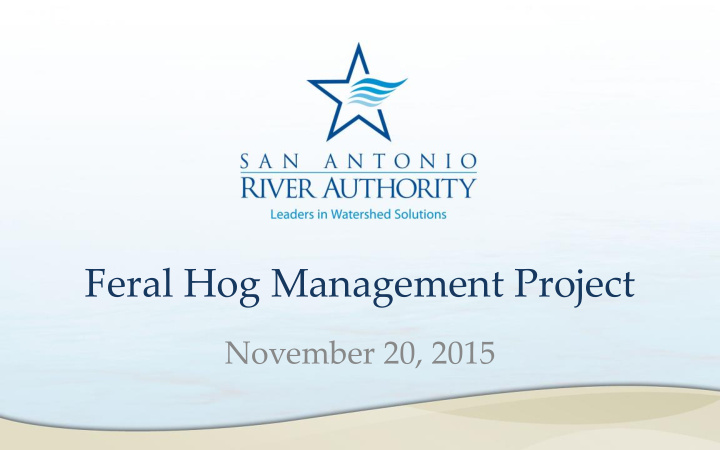



Feral Hog Management Project November 20, 2015
Sus scrofa 2
Feral Hogs in Texas • Current estimates at 2.6 million hogs in Texas • Cause $500 million dollars worth of damage per year throughout Texas • Cause $52 million dollars worth of damage to Texas agriculture • Cost landowners $7 million a year to control 3
Feral Hogs in Texas • 29% of the population is harvested annually • 60% of population would have to be removed annually to remain at current population levels 4
Distribution 5
Feral Hog Biology • First Introduced by Spanish Explorers as a source of lard and meat • Mixture of Eurasian Wild Boar and Domestic Pigs • Coat comes in a variety of colors • Shoulder height of 36 inches • Average size is between 150-400 pounds • Average age is 4 to 5 years, but can live up to 8 years 6
CiboloCreek 7
Feral Hog Biology • Have four continuously growing tusks with the lower two being constantly sharpened by the opening and closing of the jaws • Omnivorous – opportunistic feeders, eating whatever is seasonally available 8
Feral Hog Reproduction • Sows – Pregnant at three months – Gestation cycle is 3 months, 3 weeks, 3 days – Three litters every two years of 8-12 piglets • Polyestrous • Multiple Paternity 9
Feral Hog Disease • • Psuedorabies Porcine Reproductive and Respiratory Syndrome • Swine Brucellosis • Salmonella • Classic Swine Fever • Trichinosis • African Swine Fever • Streptococcus • Bovine Tuberculosis • Vesicular Disease – Foot & • Influenza Mouth Disease • Tularemia • Ticks, Fleas, & Lice • West Nile Virus • Internal Parasites • E. coli • Anthrax 10
Feral Hog Behavior • Found everywhere; forests, swamps, brush lands, and deserts • Diurnal in the winter months; nocturnal during summer • Cause damage to agriculture crops and predation of livestock 11
Feral Hog Behavior • Compete with local wildlife for resources. 12
Feral Hog Behavior • Rooting – Damage native plants – Crop damage • Wallow – Increases turbidity in streams and rivers – Increases bacteria by depositing feces • Tree scratching • Trampling Vegetation 13
Rooting along Clifton Branch 14
Rooting along Leon Creek Bed 15
Wallow along Leon Creek 16
Wallow along Medina River 17
Tree Scratch along Medina River 18
19
Bacteria • E. coli is an indicator organism for fecal contamination • Will die fairly quick in grass, but can live for months in water and sediment • Children, elderly, and immunocompromised are most susceptible 20
Bacterial Source Tracking 21
Bacterial Source Tracking Results Runs 1-8 (n=486) 10 Most Common Isolate Origins 60 51 50 48 47 40 34 33 32 28 30 25 23 23 20 10 0 Feral Hog Opossum Cattle Human Coyote Chicken Goat Duck Raccoon Dog 22
SAR Impairment: Bacteria 23
Results • Results are reported in the 2013 Basin Summary Report. 24
Natural Management: Predators 25
Management of Feral Hogs • Can manage at any time with a valid Texas Hunting License, unless they are causing depredation on your property • Landowners permission 26
Four Methods for Management Shooting 27
Four Methods for Management Snaring 28
Four Methods for Management Trapping 29
Four Methods for Management Hunting with Trained Dogs 30
Feral Hog Management Project 31
Texas A&M AgriLife • Workshops for landowners – Developing Best Management Practices (BMPs) – Tips on increasing the amount of hogs captured – Designing more efficient traps – New technology – Landowners can share their own experiences 32
Texas A&M AgriLife • Informative Brochures • Online assistance – Newspaper and online write-ups – Youtube videos 33
USDA-APHIS Wildlife Services • Wildlife Technicians were hired October 15, 2015 – Bexar and Wilson – Karnes and Goliad • Landowners will be identified 34
USDA-APHIS Wildlife Services • Direct removal of feral swine – Aerial gunning – Trapping – Snaring – Trained Dogs • Equipment loan program 35
Questions? 36
Recommend
More recommend